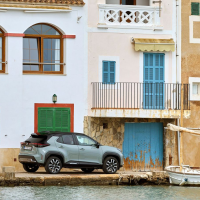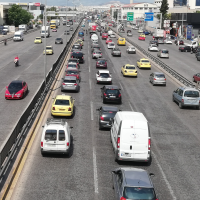GoCar.gr speaks to Neil Martin
Ferrari's Head of Operation and Research gives an insight on his job
- -
- -

Often a race is decided on the strategy calls. A lap out longer or an earlier call might cost a win. Creating a strategy is a very complex operation and is based on the work from people on and off the track. The man heading the Operation and Research department, which has a basic task to maximize the chances for the best result, is Neil Martin. You won’t find him at the track during the race. He and his team is working from the Ferrari HQ in Maranello during the race, supporting the team at the track. GoCar.gr caught up with Neil Martin to find out what his work is all about
Neil, you studied mathematics and computer science at University of Southampton and you MSc paper was on risk assessment. How did you take the decision to show this MSc paper to an F1 team?
After completing my first degree studying Mathematics with Computer Science, I undertook an MSc in Operational Research in 1994-5. As part of this MSc course I had to apply the O.R. techniques that I had learned to a real world problem.
Southampton University had set up a number of projects with high profile Companies. However I was really interested in Formula 1 and, with the re-introduction of refueling, I asked my supervisor (Prof. Chris Potts): if I could get a Formula 1 team to sponsor a Race Strategy project, would that be of sufficient mathematical complexity for a project? The University said “yes” so I wrote to two Formula 1 teams, and McLaren International Ltd (as it was then) replied positively.
I was supplied with some information from races, in paper format. I had to type in all of the sector times for every car, for every session, for every race event for analysis – in 1994 it was all paper timing information, OCR (optical character recognition) was only in its infancy and more trouble than it was worth.
I remember putting a model together from which it appeared that teams were pitting too early: they appeared to be missing the ‘free’ pitstop that you got at the beginning of the race as you didn’t lose time filling up with fuel.
Then for one race, using only data available prior to the race, the model showed that McLaren should have one-stopped, something that the Team had only worked out after the event. As a result, they became very interested in the whole area.
Functionality development requests soon followed and after my MSc submission and a couple of extended contracts with McLaren, I finally joined the Team as an employee in October 1996.
Your name appeared on the press when you made a strategy call via email in the 2005 Monaco GP that helped Kimi Raikkonen taking the win. What were your feelings at that time?
I found out on Monday after the race, a friend of mine at McLaren said “You are in the Telegraph”, I thought he was just joking, however by mid-morning someone had left a copy on my desk.
I was fairly surprised, as all I had done was the same thing I’d done week in and week out for years, nothing special.
I was also bemused by how the events got reported. It was interesting, as whilst there were elements of truth in it, it wasn’t exactly how I remembered the events!
Since 2011 you are working at Ferrari as head of the Operations Research department. Can you please enlighten us what are your job activities?
I am in charge of a group that, in effect, acts as an internal consultancy to the rest of the business.
The group is composed of a balanced mix of mathematical modelling and software engineering. We look at various areas of the Company to assist where we can by observing the current process or activity in place, modelling it and then, where appropriate, optimising or putting new understandings, processes or software in place to improve.
You are since 1996 in F1, can you please explain how the strategy tools and strategy calls in general have evolved since then?
In 1995, as a student, I created my first algorithms - it was a single car, single track, with parameters of weight effect, fuel load, fuel flow time, pitstop crew time, pitlane time loss and tyre degradation. Essentially it answered the question: Is Strategy A quicker to the end of the race than Strategy B?
It was a standalone application which was run pre-race by Race Engineers at trackside.
Numerous feature request enhancements were then incorporated however the next big breakthrough was the use of Monte Carlo techniques in 1998.
This allowed us to consider all cars in the race, traffic patterns, Safety Cars, overtaking and other random events. The results were interesting because when we move into the stochastic world we produce outputs like: If we undertake a 2-stop strategy we give ourselves approximately 20% exposure to finishing 1st or 2nd, but if we get stuck in traffic, we will most likely finish 7th or below; however if we undertake a 1-stop strategy we will most likely finish 3rd or 4th position, but unlikely to finish as high as 1st or indeed as low as 7th. So for the first time from the simulation we could visualise the risk associated with each option, and therefore a Team’s appetite for risk could be taken into consideration.
Whilst a huge step forward, by embracing risk we blurred the lines: before the Engineers had the result of “a 1 stop is quicker than a 2 stop” which seemed more clear cut, if somewhat crude.
Up to this point, all of the development was still offline and analysis was carried out pre-race. There were no data feeds which we were able to use to run real time, other than manually typing in the time gap to the car of interest on each lap to determine whether we were ahead of or behind our predicted schedule.
Soon I had written so much software that the trackside engineers wanted someone to travel to races to run some of it, so that became me. In 1999 there was no strategy audio communications channel to the pitwall, only paper printouts. I would run across to the pitwall from the garage, printouts in hand, and shout in their ears above the car noise, trying to illustrate one point or another.
Over time more tools matured, they were networked and improved trackside operational awareness and execution. Positioning cars on track in free air etc.
The next moment when we were able to make a leap, was in 2001 when the FOM first provided electronic timing data for all cars, live during sessions. This enabled in-race strategy to be undertaken in a more robust way. New screens were developed to take advantage of this real time information. Further, it allowed us to run real time Monte Carlo simulations to answer questions like: ‘Given the race information to the current lap, what is the best action to undertake if our competitor executes a three stop strategy?’, ‘What is the best strategy for our competitors to use?’
The next evolution was remote working from the factory, an Operations Room or Remote Garage with people monitoring various aspects of car performance, all communicating via intercom to trackside. From here, the amount of data available has increased, the model fidelities have continuously improved and general organic growth has occurred in the area.
What is procedure in general on approaching a race
weekend?
A week prior to the event the preliminary analysis is compiled with a view to setting the scene and our expectations for the race. This normally results in one or two candidate strategies.
Then we collect data from Free Practice 1 & 2 and update our expectations based on the information collected. This information on us and our competitors not only allows us to plan for the race, but also for qualifying strategies.
On Friday we run a lot of simulations to determine how other teams are likely to approach the race given their specific strengths.
Saturday, we use to confirm the data collected from Free Practice 3, and at this time we also finalise the Qualifying cut-off time expectation, for the bottom cars.
After qualifying, with the additional information of grid positions, we are back to running simulations to understand what our expectations are, and indeed what our risk profile going into the race should be. We are understanding the likely traffic patterns and go through a number of candidate scenarios.
A strategy meeting is held with trackside on Saturday evening. In the first meeting on Sunday, we finalise these plans and options with the drivers to ensure that everyone knows what we need to do and the likely outcomes.
Are numbers always telling the truth or is "gut feeling" sometimes stronger ?
In the very beginning when I was the 'new kid with numbers', people with years of experience – who were mainly on the pitwall and were at the top of the Company - would remember a certain set of criteria at a certain race and cite this as the reason why the new methods were about to fail.
Atypical events will, by definition, happen from time to time and it is this information which people tend to remember – especially if in that given race you had a bad result as a consequence.
It didn’t take long, consistently saying to them “You can do this, but the likely outcome will be X or Y” and those outcomes subsequently occurring, before they came around.
Overall a healthy level of scepticism is good, to keep us all on our toes and to stress test the solutions, but flawed logic rarely wastes my time these days.
What are the nightmares of a strategist, the unknown factors that make the difference in the end?
Sometimes knowledge is no defence. You can see a situation developing, predict it perfectly, but at the same time you know even if you make the best calls, you are destined to lose places due to various parameters beyond your control.
From the strategy analysis, what is the gap to top of the competitors today?
I’m sure each team has its own bespoke performance indices which cover drivers, tyre types, chassis, circuits types etc. Overall metrics of this nature are a little too cumbersome to quote and be of any genuine use. They can also be misinterpreted or not fully understood.
In order to create a strategy module the vital part is to gain data. How many MB of data are you getting out of one lap and now many sensors are used to collect the data?
It depends on what level you wish to consider your strategy. Superficially, and surprisingly, you need very little data real time; you can get away with just a laptime for you and your competitors.
However, access to sector times (3 per lap) gives you better fidelity, and if we consider GPS at 5HZ for all cars, then you can do a better job again. This all equates to about 1mb per lap of information. If we now include access to data on our own car, the data rises to approximately 10mb per car per lap.
What makes you leave the office after a race weekend as a happy man, besides a win?
I’m guessing that a 1-2 isn’t the answer you are looking for! I think I have lived motor racing professionally for 19 years, and at that point your mood does tend to be affected by your on track performance.
However, knowing that we have worked to the best of our ability as a Team, right across a Race Weekend is also important: providing clear, timely and accurate assessments of situations, options and risks; and facilitating the best possible decision making.
















 και στη συνέχεια 'Προσθήκη στην οθόνη αφετηρίας'
και στη συνέχεια 'Προσθήκη στην οθόνη αφετηρίας'